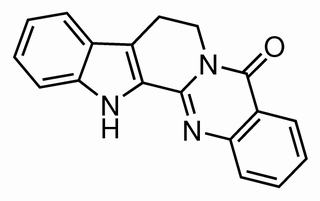Home
Products
Rutaecarpine



| Product Name | Rutaecarpine |
| Price: | $15 / 20mg |
| Catalog No.: | CN01451 |
| CAS No.: | 84-26-4 |
| Molecular Formula: | C18H13N3O |
| Molecular Weight: | 287.3 g/mol |
| Purity: | >=98% |
| Type of Compound: | Alkaloids |
| Physical Desc.: | Yellow powder |
| Source: | The fruits of Evodia rutaecarpa (Juss.) Benth. |
| Solvent: | Chloroform, Dichloromethane, Ethyl Acetate, DMSO, Acetone, etc. |
| SMILES: | O=c1c2ccccc2nc2n1CCc1c2[nH]c2c1cccc2 |
| Contact us | |
|---|---|
| First Name: | |
| Last Name: | |
| E-mail: | |
| Question: | |
| Description | Rutaecarpine, an alkaloid of Evodia rutaecarpa, is an inhibitor of COX-2 with an IC50 value of 0.28 μM. |
| Target | COX-2:0.28 μM (IC50, in BMMC) COX-1:8.7 μM (IC50, in BMMC) |
| In Vitro | Rutaecarpine has shown a variety of intriguing biological properties such as anti-thrombotic, anticancer, anti-inflammatory and analgesic, anti-obesity and thermoregulatory, vasorelaxing activity, as well as effects on the cardiovascular and endocrine systems[2]. Rutaecarpine inhibits COX-2 and COX-1 dependent phases of PGD2 generation in BMMC in a concentration-dependent manner with an IC50 of 0.28 μM and 8.7 μM, respectively. It inhibits COX-2-dependent conversion of exogenous arachidonic acid to PGE2 in a dose-dependent manner by the COX-2-transfected HEK293 cells[1]. |
| In Vivo | Rutaecarpine showed in vivo anti-inflammatory activity on rat l-carrageenan induced paw edema by intraperitoneal administration[1]. Rutaecarpine significantly decreases the number of antibody-forming cells and causes weight decrease in spleen in a dose-dependent manner. In addition, rutaecarpine administered mice exhibit reduced splenic cellularity, decreased numbers of total T cells, CD4+ cells, CD8+ cells, and B cells in spleen. IL-2, interferon and IL-10 mRNA expressions are suppressed significantly by rutaecarpine treatment. The number of CD4+IL-2+ cells is reduced significantly following administration of mice with rutaecarpine[3]. |
| Cell Assay | Rutaecarpine is dissolved in DMSO and diluted with appropriate medium before use. COX-1 and COX-2 cDNA-transfected HEK293 cells are prepared. For measuring inhibitory activity on COX-1 and COX-2 by rutaecarpine, cells in 1 mL of culture medium are seeded into each well of 24-well. After culture for 4 days, the supernatants are removed and 250 mL of fresh medium is added to the cells with or without rutaecarpine. After preincubation for 5 h at 37°C, the cells are further incubated at 37°C for 30 min with 50 mM arachidonic acid. All reactions are stopped by centrifugation at 120 g at 4°C for 5 min. Concentrations of PGE2 in the supernatant are measured[1]. |
| Animal Admin | Rats: Rutaecarpine is dissolved in 0.1% carboxymethyl cellulose and diluted with appropriate medium before use. Male Splague-Dawley (SD) rats (180-220 g) are used in the study. Rutaecarpine administered intraperitoneally and, 1 h later, l-carrageenan solution is injected to right hind paw of rats. Paw volumes are measured using plethysmometer 5 h after l-carrageenan injection[1]. Mice: For the antibody response to SRBCs, rutaecarpine is administered at a single dose of 10 mg/kg, 20 mg/kg, 40 mg/kg or 80 mg/kg in 10 mL of 1% povidone solution intravenously. Control animals are given 1% povidone solution at 10 mL/kg. Specific pathogen-free female BALB/c mice are used in the study[3]. |
| Density | 1.5±0.1 g/cm3 |
| Boiling Point | 550.1±60.0 °C at 760 mmHg |
| Flash Point | 286.5±32.9 °C |
| Exact Mass | 287.105865 |
| PSA | 50.68000 |
| LogP | 2.03 |
| Vapour Pressure | 0.0±1.5 mmHg at 25°C |
| Storage condition | 2-8°C |